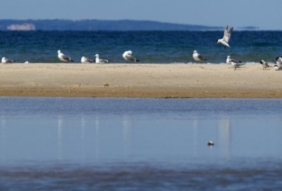
Posted on June 14, 2016
By Mark Johnson, Record Eagle
Dredging at the Platte River’s mouth on the Lake Michigan shoreline is scheduled to resume this fall following a three-year hiatus.
The Michigan Department of Natural Resources will facilitate the dredging if a permit is approved by the Department of Environmental Quality and other organizations.
The effort to cut a deeper channel where the river meets the lake would commence after Labor Day and continue through September, allowing anglers access during the coho salmon run. Work to complete the Platte River Mouth Restoration and Access Plan and an accompanying environmental assessment will continue — the assessment is expected to be available for public comment and review in the fall.
The public scoping analysis report — a bundle of 64 opinions from the public, several governmental organizations and businesses — was released June 3. Participants weighed in on issues including dredging, facilities and boat access.
“We are looking for alternative means for providing access, environmental impacts we haven’t thought of, solutions for problems, and issues that might arise from changes,” said Kevin Skerl, chief of the natural resources program at Sleeping Bear Dunes National Lakeshore. “We are not as much counting how many people said what specific things and trying to weigh them out. It’s not as much a voting process as it is a tally.”
Dredging at the river’s mouth is a point of contention.
Anglers in support the dredging to allow boats to safely navigate the transition between the river and Lake Michigan. Meanwhile others are concerned such actions may be harming nearby threatened or endangered species, like the piping plover and pitcher’s thistle.
The Benzie Fishing Coalition participated in the scoping report, encouraging dredging at the river mouth and working toward an alternative to using the Platte River to access the bay. Coalition President Edward McIntosh said shallow water at the river mouth makes it difficult for boaters to access the river from the bay.
“After a lot of campaigning, we have finally won our point,” he said.
A storm in the 1960s killed several boaters when they couldn’t access the undredged river, resulting in boats overturning as they searchers for alternate routes to shore, McIntosh said. Dredging commenced soon after and he stressed it must continue to ensure safety for boaters and anglers.
Dredging during the past 40 years raised the beach 4 to 6 feet in some locations, changing the habitat for species that otherwise may have used it, Skerl said. The river’s natural flow was altered by the dredging which interrupted the natural process of erosion and deposition.
“The point is the modifications aren’t natural and aren’t seen from the park’s perspective as restorative,” Skerl said.
It’s possible a endangered piping plover nesting pair in the area may have been impacted, although there is no concrete evidence, he said.
Officials will consider additional comments regarding alternatives, visitor-related issues, boater safety, the fishery and other concerns as they continue to gather data and complete field analyses for the environmental assessment.
Go to parkplanning.nps.gov/platte for further information on the plan and scoping report.
Source: Record Eagle





